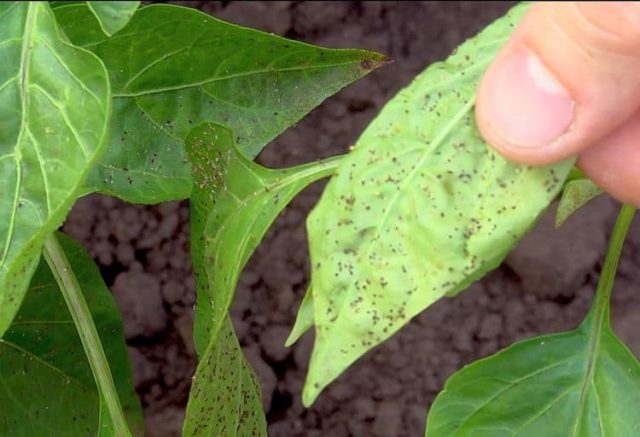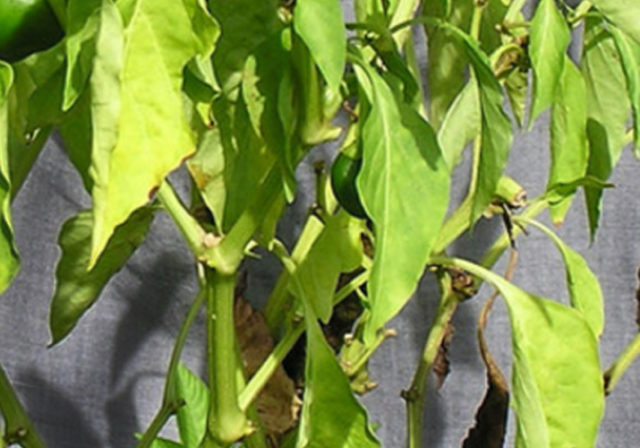Content
The leaves of pepper seedlings turn yellow and fall off for many reasons. Sometimes this process is natural, but much more often it indicates mistakes made during cultivation.
List of reasons why the leaves of pepper seedlings turn yellow
Pepper seedlings cannot be called unpretentious; they react quite sensitively to any violations committed in care. Most often, due to errors in cultivation, the leaves of the crop begin to turn yellow.
Incorrect soil composition
Optimal for the crop is loose, light and permeable soil with neutral acidity. Pepper grows well in soils that are rich in humus and diluted with sand, perlite and vermiculite. When preparing the soil yourself, it is recommended to mix humus with turf soil, peat, leaf sawdust and sand.
But dense and heavy soil with high acidity is not suitable. The leaves of pepper seedlings turn yellow, the plant develops poorly and slowly.
Reaction to picking
Young pepper seedlings have a very sensitive root system. The crop does not tolerate picking well; any damage to the underground part leads to the seedlings weakening.
If the roots were slightly damaged during transplantation, the plant will be able to cope with the damage, only the cotyledon leaves of the pepper seedlings will turn yellow.

After picking, it is recommended to wait 2-3 days and see if the plant comes to life on its own
But if the leaves continue to turn yellow, then you will need to use growth stimulants - Kornevin, Zircon and others. The drugs stimulate seedlings to recover, grow new roots and actively absorb nutrients from the soil.
Violation of the watering schedule
Seedlings react negatively to both lack and excess moisture. In both cases, the bell pepper seedlings on the windowsill turn yellow. The soil in the boxes should remain slightly moist, but drying out and waterlogging should not be allowed.
Peppers require settled and soft water, at room temperature - about 25 °C. It is necessary to make drainage holes at the bottom of the box to remove excess moisture. If the window sill is cold, then a wooden plank or other material should be placed under the containers to protect the root system from freezing.
Lack or excess of nutrients
Already in the first stages of growth, the crop needs periodic feeding. If pepper seedlings at home turn yellow, this may indicate a lack of nitrogen. The element is responsible for the development of green mass. If you urgently need to feed yellowing pepper seedlings, you can spray the seedlings with a weak solution of ammonia.
But at the same time, the plant also reacts poorly to excess nutrients.You can tell that there is too much fertilizer in the soil by a whitish coating around the drainage holes, which is how the sediment of mineral salts appears. In this situation, fertilizing should be stopped completely and the pepper should be supplied only with moisture for some time.
Lack or excess lighting
At home, it can be difficult to provide pepper seedlings with high-quality lighting. Most often in spring, the crop suffers from a lack of sunlight. For full development, seedlings need to receive light at least 12 hours a day, and daylight hours during the period of their active growth are much shorter. That is why containers are usually illuminated with special lamps; this protects the seedlings from yellowing and stretching.
In some cases, the leaves of pepper seedlings turn yellow from excessive lighting. In an apartment, even the wind does not remove excess heat from the sun, causing the plant to get burned.

If the box is on an eastern or southern windowsill, the leaves are especially likely to overheat under the sun's rays
Diseases and pests
Crops growing outdoors are more likely to suffer from fungi and insects. But sometimes pests and diseases affect houseplants. This usually occurs due to waterlogging or initially contaminated soil.
The leaves of bell pepper seedlings turn yellow due to the following parasites:
- spider mite, the pest can be recognized by the appearance of a light mesh on the underside of the leaves and white-gray dots on the surface of the plates;
With spider mites, frequent pimples may appear on the underside of the plates
- aphids, a small pest capable of destroying any seedling at the root, can be recognized by yellowing and curling of the leaves; insect colonies themselves are clearly visible on the seedlings.
Aphids feed on the juices of seedlings, so they can very quickly destroy peppers.
If the pepper is weakly infested with pests, then you can use a regular soap solution or an infusion of tobacco dust to control it. In case of serious damage, insecticides are used, for example, Actellik or Fitoverm.
The most common diseases affecting pepper seedlings are:
- Downy mildew, dots appear on the leaves, which later merge into light spots, and as a result, the entire leaf first turns white, then turns yellow, and then acquires a brown tint.
Downy mildew appears on seedlings under “greenhouse” conditions - waterlogging and high temperature
- Fusarium, with this disease, the tips of the lower leaves of pepper first turn yellow, and then the disease rises higher up the stem.
With fusarium wilt, the leaves not only turn yellow, but also wither
Powdery mildew fungus responds well to treatment with Fundazol. But with fusarium, diseased seedlings are simply destroyed. For the remaining ones, the soil is changed and preventive treatment with fungicides is carried out.
Why do the lower leaves of pepper seedlings turn yellow?
Sometimes the lower leaves of pepper seedlings turn yellow and fall off, while the upper ones remain green and healthy. If this happens at the stage of active growth, then most likely we are talking about a natural process. The cotyledon leaves die; they have already fulfilled their role for the plant and are no longer needed.
But in some cases, yellowing of the lower leaves may still indicate bacterial processes or nitrogen deficiency. In these cases, yellowness begins to spread up the stem over time.
What to do if pepper seedlings turn yellow
If pepper seedlings turn yellow and drop leaves, you first need to determine the most likely cause. To do this you should:
- analyze the lighting level in the room;
- assess the degree of soil moisture;
- carefully examine the seedlings for pests and signs of fungal diseases.
When yellowing appears, watering should be adjusted, since most often peppers suffer from a lack or excess of moisture. If pests and fungi are found in the soil and on the leaves, you should urgently spray the plantings with homemade or chemical products.

Antifungal treatment cannot be delayed; the entire box of seedlings may die
Prevention measures
Yellow spots on the leaves of pepper seedlings are easier to prevent than to deal with them. Healthy development of culture is ensured by competent prevention:
- To protect against infections and pests, before planting, not only the soil, but also the pepper seeds are disinfected. You can use a pink solution of potassium permanganate or fungicidal preparations. It is best to buy material for seedlings whose packaging indicates that disinfection has already been carried out by the manufacturer.
- Before laying the soil, boxes for seedlings are thoroughly washed using soda and soap.
- After the first shoots appear, additional lighting is provided so that the daylight hours are at least 12 hours. The box is placed in a place where the crop will not be in dense shade, but will not suffer from bright sun.
- Picking peppers is carried out only when necessary. It is better to plant the seeds in a separate container from the very beginning. When transshipment is carried out, the roots of the seedlings are handled very carefully and try to preserve old clods of earth on them.
- Seedlings are watered as needed. It is not necessary to set a clear schedule; you need to monitor the top layer of soil, it must remain moist.
Conclusion
The leaves of pepper seedlings turn yellow and fall off due to violations during care. Most often, errors can be easily corrected. You only need to adjust the watering and fertilizing regime, as well as provide the seedlings with enough light.












